There are several types of resistance bands, each designed for specific fitness needs and budgets—most cost between $10 and $80 per set, depending on the type and brand. Knowing the differences helps you pick the right band for strength training, rehab, or home workouts. In this guide, you’ll get clear explanations of each band type, their average costs, and the best ways to use them safely and effectively.
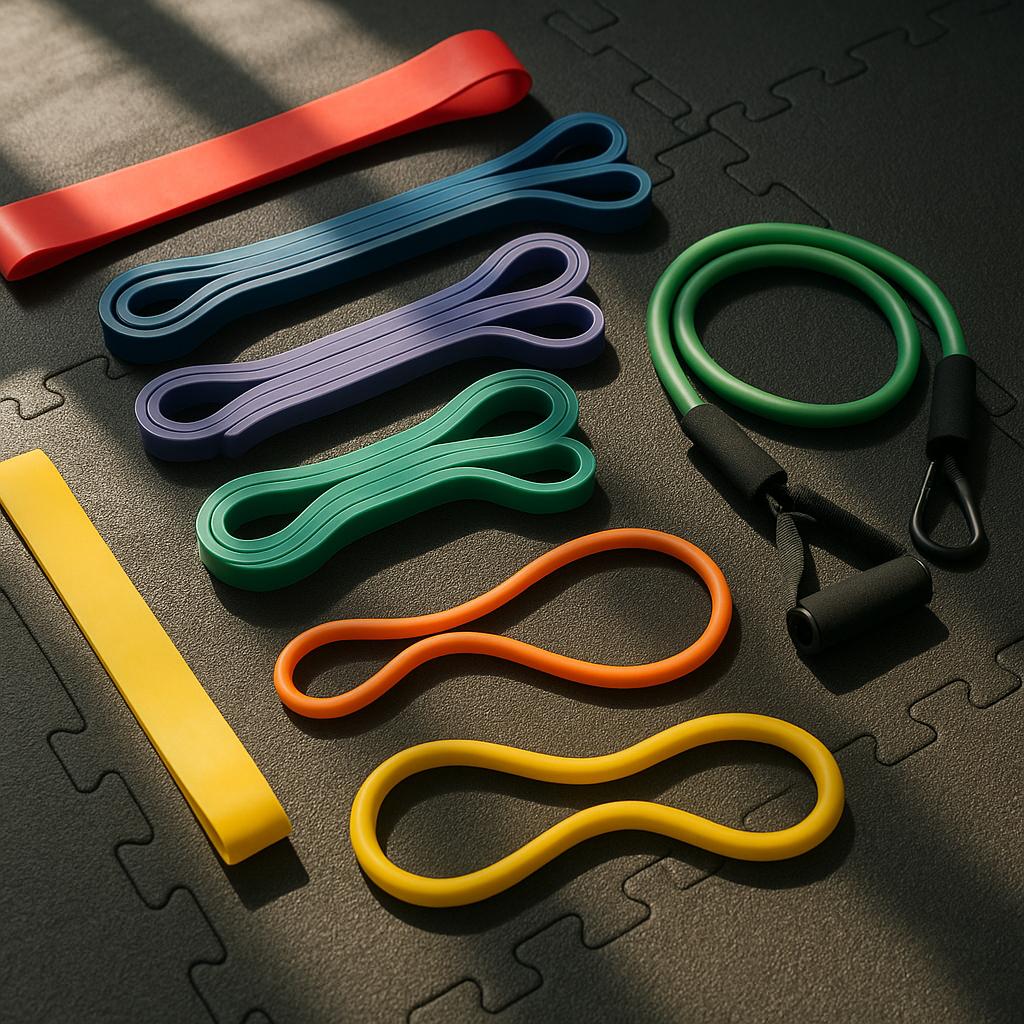
Understanding resistance bands is essential for anyone looking to exercise at home, recover from injury, or add variety to their routine. You’ll quickly learn the basics, pros and cons, and how to choose the best band for your goals. Below, we break down the key types, their uses, current pricing, and frequently asked questions. See this official guide from the American Council on Exercise for more details.
What Are Resistance Bands?
Resistance bands are stretchable, elastic bands used for strength training, rehabilitation, and mobility exercises. They come in various shapes, sizes, and resistance levels.
- Lightweight, portable, and affordable.
- Suitable for beginners to advanced users.
- Provide adjustable resistance for full-body workouts.
Learn more from Healthline’s Resistance Bands Overview.
Main Types of Resistance Bands (With Uses & Costs)
1. Therapy Bands (Flat Bands)
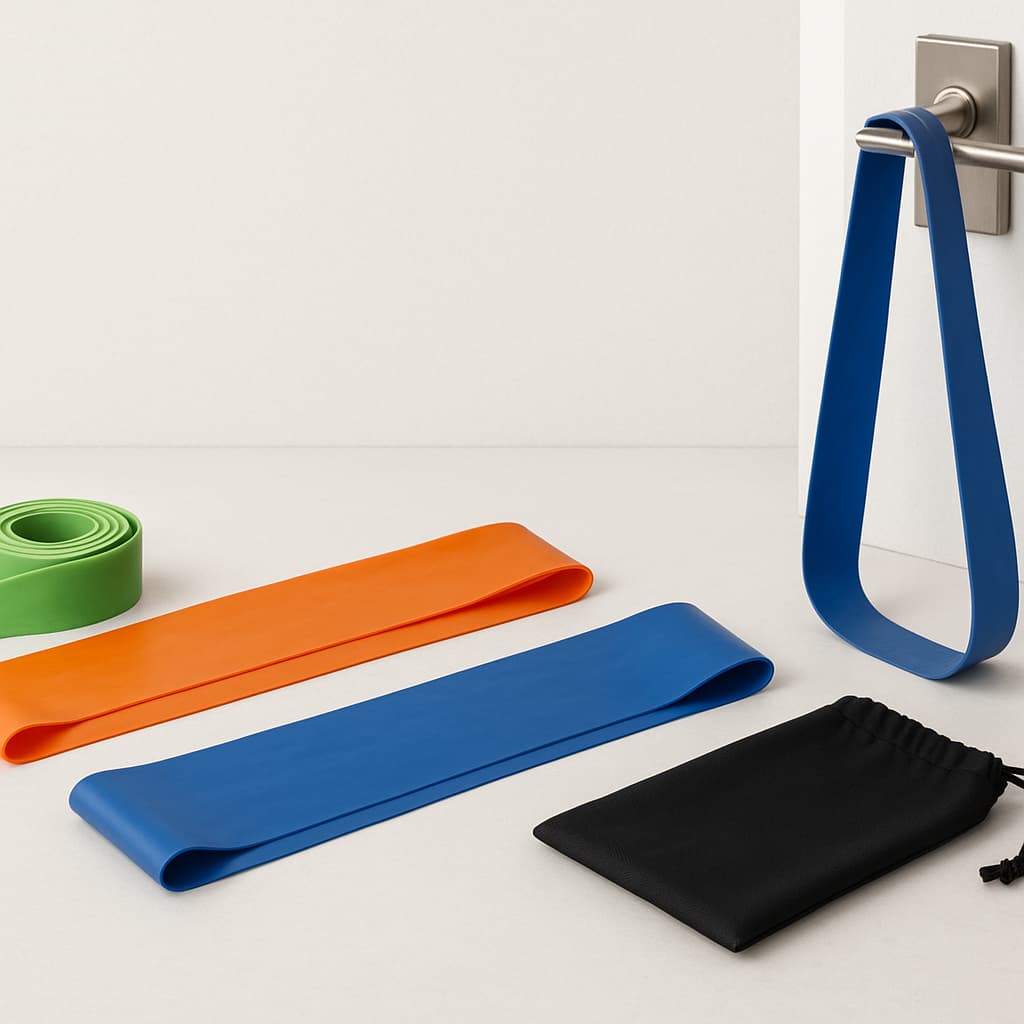
Therapy bands are flat, wide bands primarily used for rehabilitation, physical therapy, and gentle stretching.
- Best for: Physical therapy, injury recovery, gentle mobility work.
- Cost: Around $10–$15 for a 5-foot roll.
Example Uses:
- Shoulder Rehab Rotations: Anchor one end and rotate arm outward/inward to rebuild rotator cuff strength.
- Hamstring Stretch: Lie down, loop around your foot, and pull to stretch tight hamstrings.
- Warm-Up Pull-Aparts: Hold at chest height and pull apart to activate shoulders.
Pros: Lightweight, inexpensive, beginner-friendly.
Cons: Tears easily and not suited for heavy strength training.
2. Loop Bands (Mini Bands & Power Loops)
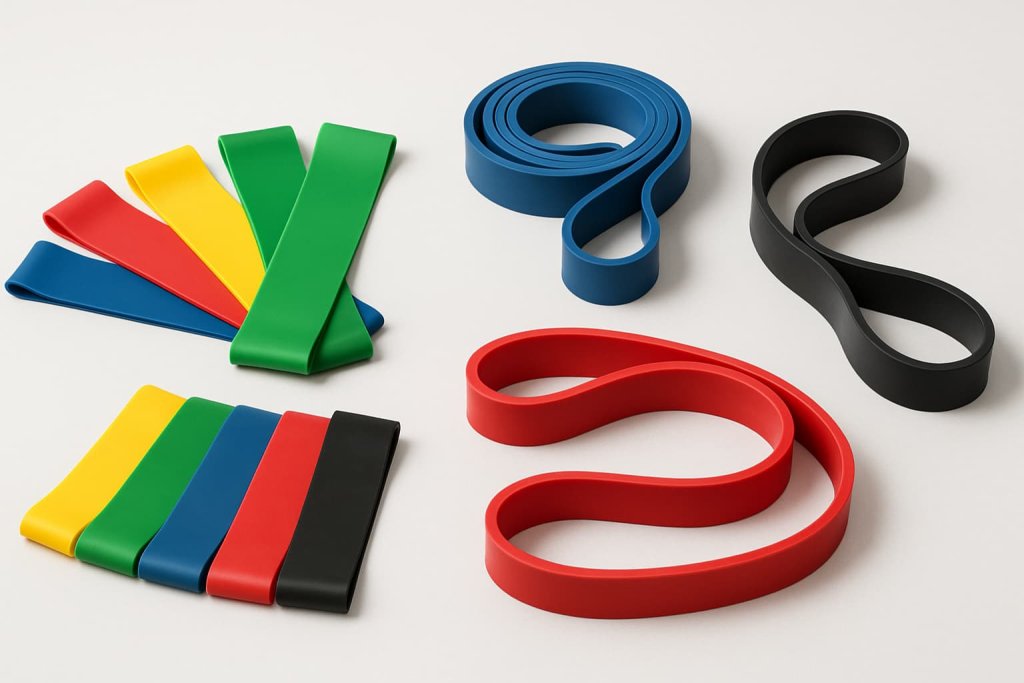
Loop bands are continuous loops ideal for lower-body activation, glute training, and even pull-up assistance.
- Mini Bands: Small loops for hips, legs, and glute work.
- Power/Super Bands: Larger loops for assisted pull-ups and heavy resistance moves.
- Cost: Mini bands $10–$20 per set; Power bands $20–$60 depending on thickness.
Example Uses:
- Mini Bands: Lateral walks, glute bridges, squats with added hip resistance.
- Power Bands: Assisted pull-ups, resistance deadlifts, banded push-ups.
Pros: Highly versatile, portable, effective for both beginners and athletes.
Cons: Mini bands roll up easily; power bands require careful anchoring.
3. Tube Bands With Handles
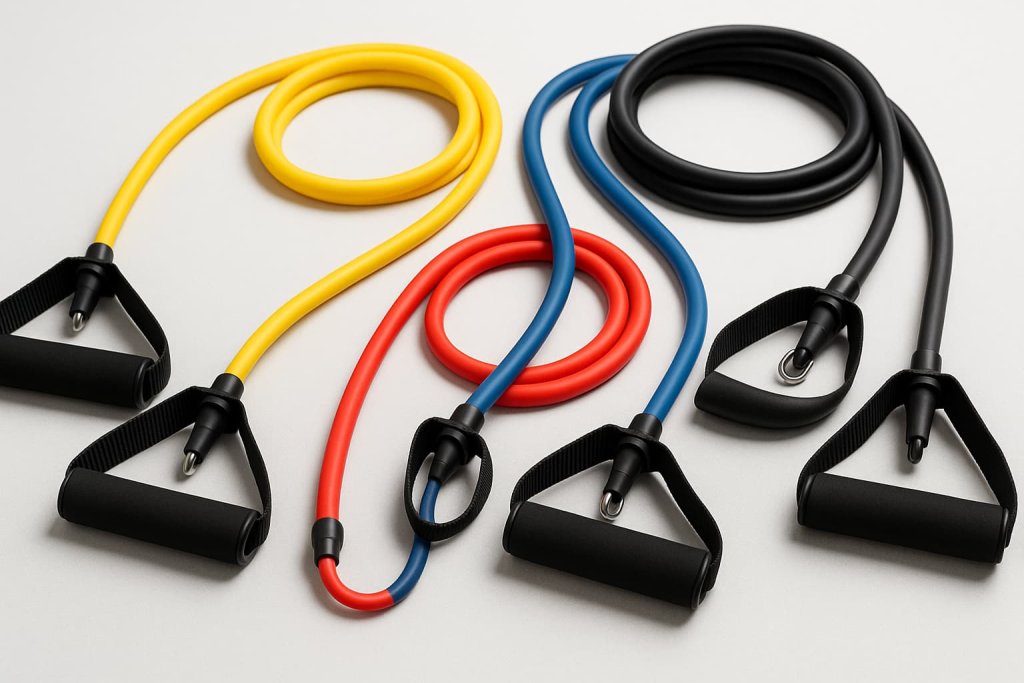
Tube bands mimic cable machines and offer more grip for upper and lower body exercises.
- Best for: Full-body resistance training, home workouts, travel.
- Cost: $20–$35 for a starter set with handles and door anchor (Life Extension, 2024).
Example Uses:
- Chest Press: Anchor behind and press forward like a bench press.
- Seated Row: Anchor at feet level, pull handles toward chest.
- Bicep Curls: Step on band and curl upward like dumbbells.
Pros: Mimics cable machine movements, comfortable grip, sold in sets.
Cons: Handles and attachment points can wear out over time.
4. Figure-8 Bands
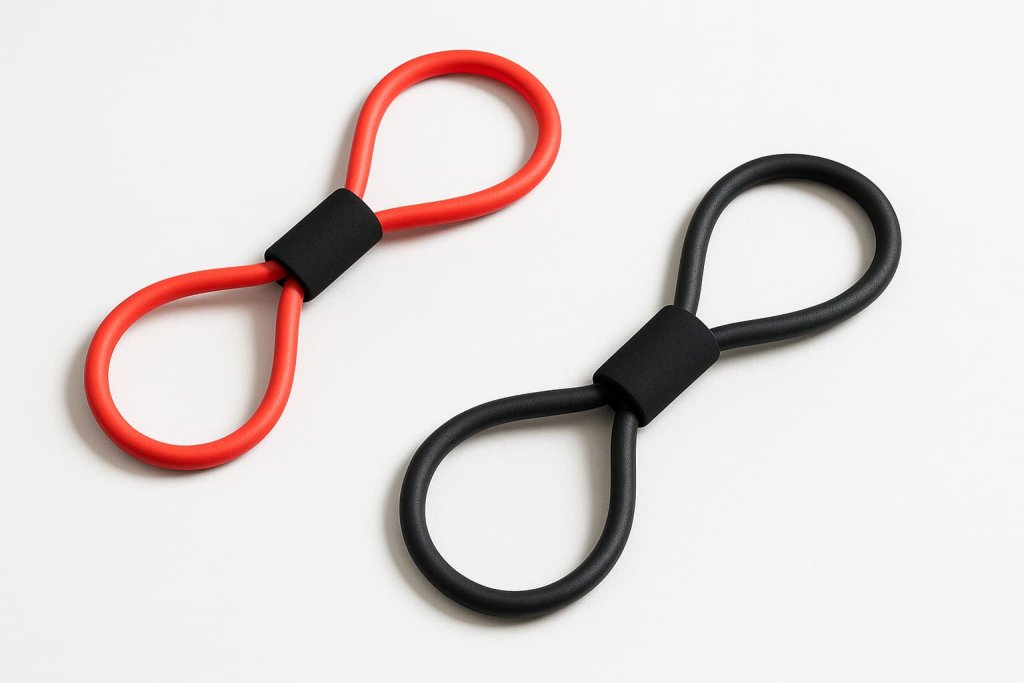
Figure-8 bands are short tubes with handles, shaped like an eight, for upper body and isometric exercises.
- Best for: Arm and chest workouts, toning, isometrics.
- Cost: $10–$20 each (Knee-Pain-Explained).
Example Uses:
- Chest Flys: Pull handles inward and outward to target chest muscles.
- Overhead Triceps Extension: Hold behind the head and extend upward.
- Shoulder Presses: Step on the middle and press handles overhead.
Pros: Compact, portable, beginner-friendly.
Cons: Limited exercise variety and fixed resistance length.
5. Fabric Bands
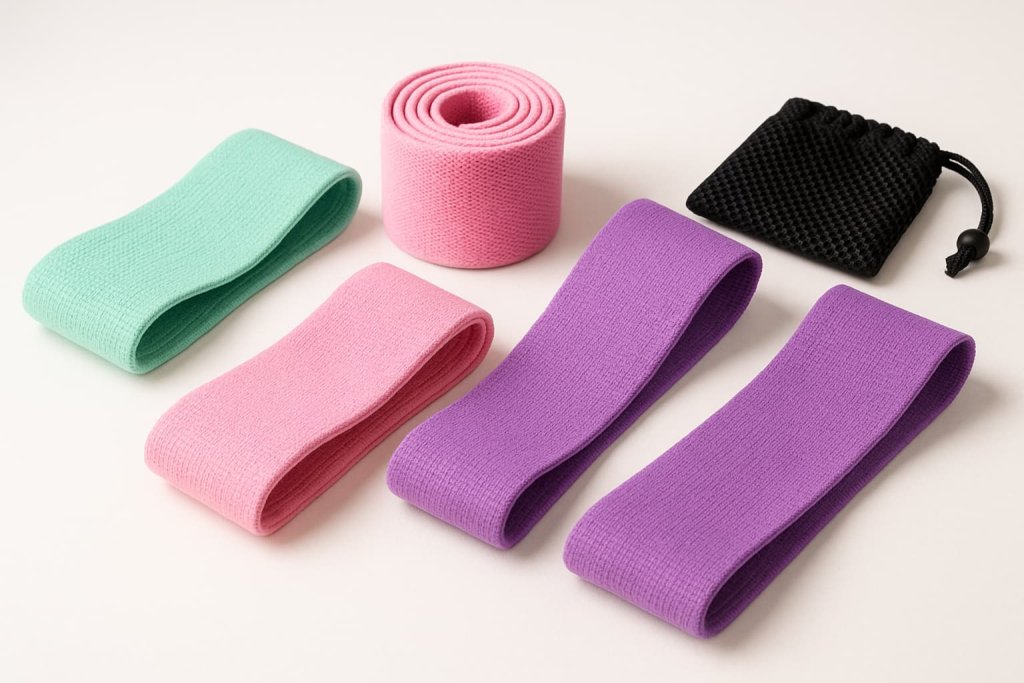
Fabric resistance bands are made of woven materials and are often used for comfort and durability, especially in lower-body exercises.
- Best for: Glute and hip exercises, home or studio use.
- Cost: $20–$40 per set.
Example Uses:
- Lateral Walks: Strengthen hip abductors with side steps.
- Hip Thrusts: Place above knees for stronger glute activation.
- Clamshells: Lie on your side and open knees against resistance.
Pros: Comfortable, non-slip, long-lasting.
Cons: Bulkier than latex bands and less stretch range.
6. Ring & Pilates Bands
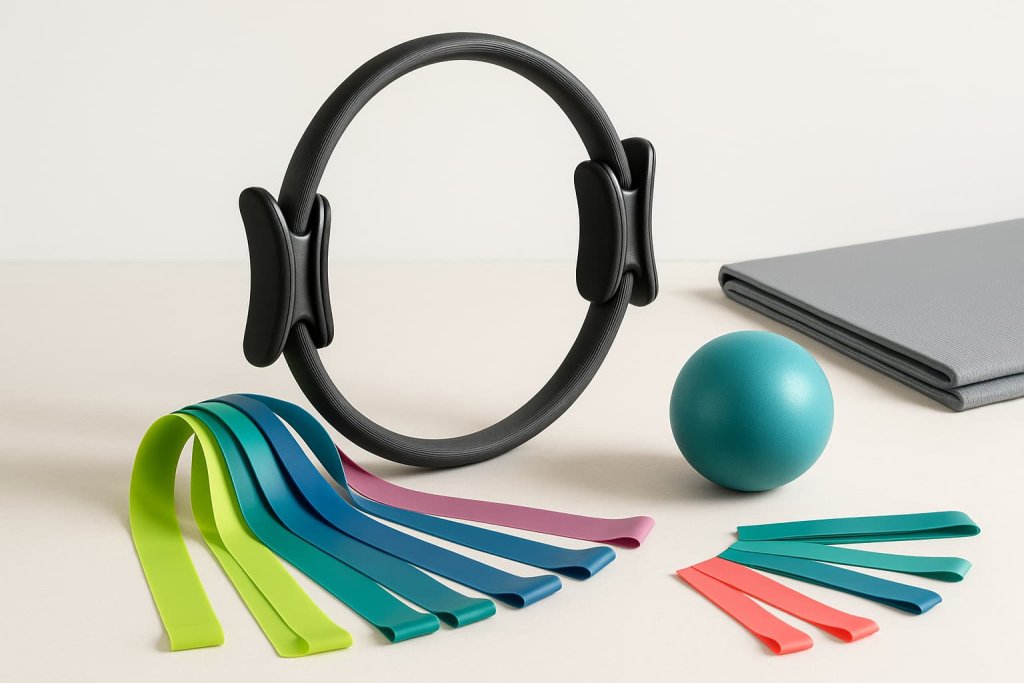
Ring bands and Pilates circles add variety and are used in pilates and flexibility routines.
- Best for: Core, stability, and flexibility workouts.
- Cost: $15–$35 per ring (Verywell Fit, 2024).
Example Uses:
- Inner Thigh Squeeze: Place between thighs and press inward.
- Core Twists: Hold in front and rotate side to side to engage obliques.
- Bridge with Squeeze: Place between knees during hip raises to activate core and glutes.
Pros: Great for core strength and posture, lightweight, easy to store.
Cons: Limited resistance range and not designed for heavy strength training.
Comparing Resistance Bands: Quick Reference Table
| Band Type | Typical Cost | Best For | Example Use |
|---|---|---|---|
| Therapy Bands | $10–$15 | Rehab, Stretching | Shoulder rehab, warm-up |
| Mini Loop Bands | $10–$20 | Glutes, Lower Body | Glute bridges, squats |
| Power/Super Bands | $20–$60 | Pull-ups, Heavy Lifts | Pull-up assist, deadlifts |
| Tube Bands | $20–$35/set | Full-Body Training | Rows, presses, curls |
| Figure-8 Bands | $10–$20 | Upper Body, Isometrics | Chest fly, shoulder press |
| Fabric Bands | $20–$40/set | Glutes, Comfort | Hip thrusts, lateral walks |
| Pilates Rings | $15–$35 | Core, Stability, Pilates | Inner thigh squeeze |
How to Choose the Right Resistance Band
- Consider your goals: Rehab, strength, toning, or mobility.
- Check resistance levels: Most bands are color-coded from light to heavy.
- Look for accessories: Handles, door anchors, and carrying bags add value.
- Compare durability: Fabric bands don’t roll up or pinch skin like latex.
For more advice, see American Council on Exercise: How to Choose Resistance Bands.
Tips for Safe and Effective Use
- Inspect bands regularly for tears or wear.
- Anchor bands securely to avoid snap-back.
- Start with light resistance and progress gradually.
- Always follow manufacturer instructions for care and storage.
Frequently Asked Questions
Are resistance bands as effective as weights?
Yes, resistance bands provide muscle growth and strength gains similar to free weights when used properly (Healthline, 2024).
How long do resistance bands last?
Most latex bands last 6 months to 2 years with regular use. Fabric bands tend to last longer.
Can I use resistance bands for full-body workouts?
Absolutely! They work for arms, legs, chest, back, and core.
Where can I buy resistance bands?
You can find them at:
- Amazon
- Sporting goods stores
- Fitness specialty shops
For high-quality options, check Tom’s Guide’s best resistance bands 2024 list.
Conclusion
Resistance bands are affordable, versatile tools for strength, rehab, and mobility, ranging from $10 to $80 depending on type and quality. Whether you’re recovering from injury, training at home, or building strength on the go, there’s a resistance band for every need and budget. Compare options, choose the right type, and get moving with your fitness goals today!
Ready to get started? Explore top-rated resistance bands and take your workouts to the next level.
